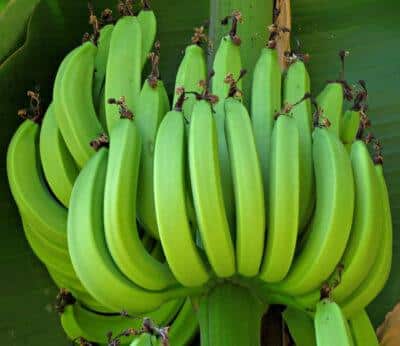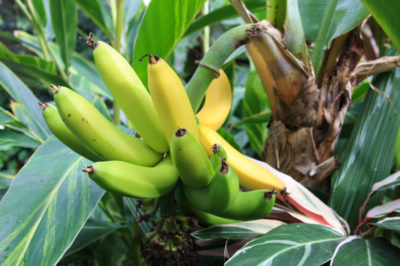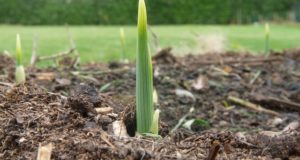
Image source: RGBstock.com
Bananas are a colorful, well-loved, widely enjoyed snack. They also are known for being a tropical food. If you’ve ever wished that you could grow your own bananas but are concerned that the climate where you live is just a bit too cold, then you’ll be happy to know that it is possible to grow this delicious treat even in areas where the weather is a bit cooler than you might consider ideal.
The first thing that you will need to do is determine which variety of banana you are going to grow. There are many plants which are marketed as “cold hardy” bananas, such as the basjoo. It is important to keep in mind, however, that while these make a beautiful addition to your landscape, many of these are considered ornamental.
For edible bananas, you might want to consider something that is a bit more tropical, but small enough to move indoors when the weather turns frigid – such as the dwarf canvendish. In some cases, you may have to pick the fruit early and let it ripen indoors, but it is possible to get edible fruit.
How to Plant
Bananas like a lot of sun. They do best with at least 12 hours of sunlight a day. They need well-draining soil. Normal potting soil or yard dirt is too heavy for most banana plants so you need to take care when choosing soil. The soil must be light and deep. Some people plant bananas in raised beds to assist with the draining. If you use a container to grow you bananas, make sure they have plenty of drainage. Bananas don’t take well to flooding.
When you choose an outdoor planting site, you’ll need to find one that is protected from wind and the cold weather, if possible. Pick a warm location on the south or southeast side of the house. Place the plant upright and plant four to six inches deep. Make sure to cover the roots well. At least half of the base should be covered in soil. It is recommended that you fertilize the banana plant lightly each time you water as bananas are considered heavy feeders. Only fertilize the plants when you see growth and water when the soil is dry to a depth of one-half inch.
The Best Source For Heirloom Herb Seeds Is Right Here!
Take precautions to protect the banana plants as the weather grows colder. Bananas can’t handle below freezing temperatures on their exposed stems. The main stem and root stock are important to maintain so the plant will come back the next season. The bulb-like root structure at the base is called a corm. This is what you must protect so you can grow your own bananas.
How To Keep Your Banana Plants Through the Winter
 The severity of your typical winter weather will determine the amount of protection that your plants will need.
The severity of your typical winter weather will determine the amount of protection that your plants will need.
For areas with milder winters:
- Gather thick mulch around the root of the “tree.” This will prevent the corm from freezing. You can cut up banana leaves to mix in the mulch, as well as grass-trimmings, wood chips, shredded paper and leaves. Do not use peat moss as it will keep the soil too wet and will ruin the corm. For wet winters, put the mulch in plastic bags and put them over the corms. The mulch will still insulate but not be wet.
- Keeping the banana stem from freezing is the next important thing to accomplish. As long as the summer growth – the green stem – stays green and unfrozen, it will continue to survive and grow. The summer growth includes the fully-formed flower with a bud inside. Keeping that alive will give you a jump on the next growing season since the plant doesn’t have to start all over again in the spring. It also gives you a head start on producing fruit by next winter. Bananas take 15 months to two years to grow fruit.
For areas with moderate winters:
- If you are in an area that has intermittent cold winters with a few freezes, you can make covers for your banana plants. Tomato frames, or cages, can be used and covered with plastic sheeting. They work well for those cold nights and may be taken off when not needed. It’s not a good idea to wrap the banana stem. If wrapped, the wrap can freeze where it touches the stem. In warm weather, the wrap touching the stem can allow the plant to overheat and die as a result.
For areas with cold to harsh winters:
- For those good, solid winters with a steady freeze, use burlap or blankets to wrap around the stem (for winters where the ground will freeze solid and temperatures remain low, this is needed.) Next cover the wrap with plastic to protect the plant from wetness. Plastic bags work well. A plastic pot, with garbage bags on top to keep water off, and string wound around it, will keep everything intact when the winter winds blow. If you have bags of fall leaves, you can place them against the stems. Patio cushions work well as insulation, too.
- For the harshest winters, where the ground is frozen deep, digging up the corm and storing it inside where it is dry is the best solution. Digging it up won’t be difficult because bananas have a root system that is very shallow. Simply dig up the whole corm and stem, dust off any loose soil and store the plant either laying down or against a wall. It needs to be kept under 60 degrees Fahrenheit and dry. Support the plant with stakes when you replant it outside in the spring. Remember to use wide strips of cloth, and not string. String is too rough.
By following these tips and hints, you will be able to enjoy your banana plants, care for them over the winter, and be able to have a taste of the tropics even in cooler climates.
Have you grown bananas? Do you have any tips? Share them in the section below:
Learn Everything You Need To Know When Growing Herbs. Read More Here.
 Off The Grid News Better Ideas For Off The Grid Living
Off The Grid News Better Ideas For Off The Grid Living




